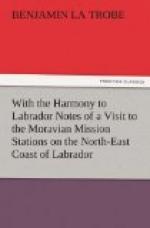WIDOWS AT NAIN. It was a good day for lonely Eskimo women of this class when the Gospel came to their shores. I made a point of inquiring at each station as to the status of the widows and the fatherless, and found that everywhere they are well cared for. Indeed, the widows invariably stand in the first rank of those for whom regular employment is found by the Society for the Furtherance of the Gospel. They gratefully acknowledged this. Several of them also gave me a special commission, which I hereby discharge to the best of my ability. It was this, “Give my greeting to all the widows in Europe.” Perhaps they thought it would be as easy for the visitor from England to do this on his return, as to inquire after all the widows in Labrador.
The five aged women in our picture are Adolfina (standing behind), Marta (seated to her right), and Hulda and Beata (to her left). Amalia (in the centre of the foreground) is attired in skirts after European fashion, though she has on a pair of the Eskimo boots indispensable in such a land. The rest are dressed in full Eskimo costume. It will be seen that their sillapaks and trousers are ornamented with broad coloured braid, and the hood, which falls back over their shoulders, is edged with dog’s skin and adorned with a strip of embroidery. Hulda is a worthy door-keeper in the church, and a valued servant in the mission-house of many years’ standing. The other group represents
THE CHOIR AT NAIN. We have already referred to the musical taste and ability of many of the Eskimoes, and those at Nain are not behind the Hopedalers in this respect. The man with the violoncello seated in the centre is Abraham, the native helper mentioned in a previous paragraph. To his right is Nathanael, with a violin. He is the schoolmaster at Nain, and his wife Frederika is seated at his right hand. One day in 1887, Nathanael was seen shaking his fists at the mission house. What had ruffled his temper? He had been told by some fishermen that Queen Victoria, to mark her Jubilee, had sent a present of a suit of clothes to every schoolmaster in her dominions. As his had not reached him, he suspected the missionaries of withholding it. This is a characteristic instance of the credulity with which the Eskimoes accept the statements of strangers and the mistrust they are too apt to show towards those who have long proved themselves their most disinterested friends.
“GOD’S ACRE.”
The burial ground at Nain is the best kept in Labrador. Others are neat and tidily arranged, but this decidedly bears off the palm. It is finely situated, commanding a view seaward, and an Easter morning service in this peaceful resting-place of the departed must be impressive indeed, as the rising sun sheds his first rays across frozen sea and snowy islands on a company of Christian Eskimoes, rejoicing in Him who is the Resurrection and the Life, and not sorrowing hopelessly for their dead. I know no better name for such a sacred enclosure, where the bodies of those who have died in the Lord are sown in hope, than the beautiful German term, “God’s Acre.”




